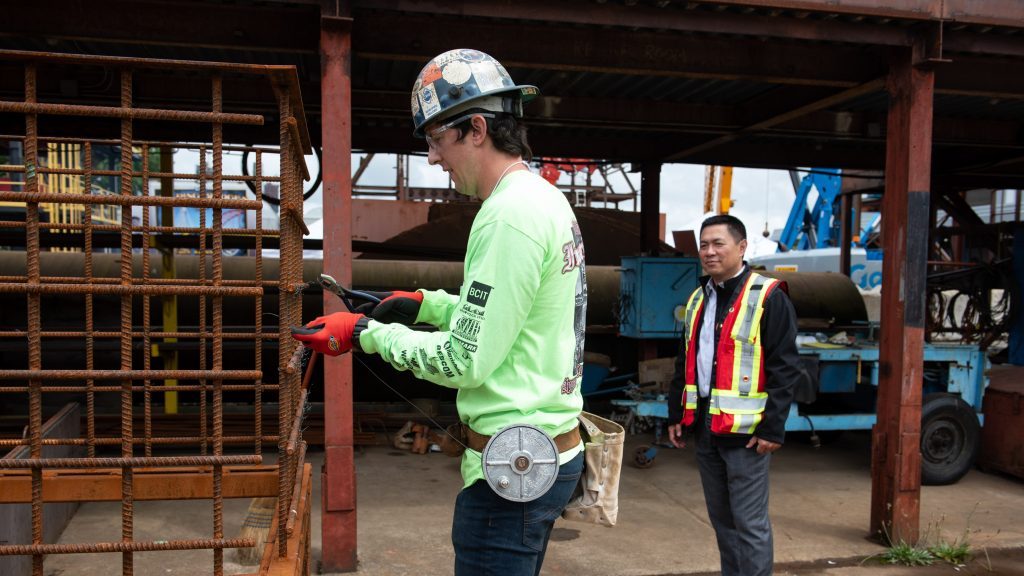Metal trades in Western Canada will need to keep recruitment pressure on if they want to stave off severe labour shortages according to labour report surveys. But, even with recruiting efforts, some shortage of labour will occur and competition amongst employers will increase the price of labour.
The exit of skilled baby boomers is only one challenge faced but metal trades also face a job identity problem plus the rigours and hazards of the work.
Hardest hit is B.C., BuildForce Canada’s regional labour report indicates that for B.C. the supply of boilermakers will not match market demand until 2025 while ironworkers and structural metal fabricators will face some acute shortages and not meet market demand until 2022.
Chris Paige, president of the boilermakers Local 359, said supply is still matching demand on the union side. “We have a few retiring but we have the apprentices coming in to fill those positions,” he said, but industries are down. He sees the need to kick-starting more B.C. industrial projects and sectors such as forestry, the marine sector, and energy, back on track to facilitate more apprenticeship training. As an example, he points to the pulp mill industry which in 1980 had 22 plants in B.C. and is now down to 13.
Paige said his trade is not for everyone as it is physically demanding, may involve months of not working and then working seven days a week, 12-14 hours days, in remote project.
“You grab your boots and be ready to travel,” he said, a factor that can be hard on family life.
B.C.’s premier training facility for new entrants, the BC Institute of Technology (BCIT) has noted the trend. The foundation classes for ironworker — and boilermakers too — are not always full, said James Cai, associate dean, overseeing the institute’s three metal-working programs: ironworker, boilermaker, and fabricator. BCIT’s foundation courses work in conjunction with the unions, churning through two annual intakes of 16 students a year.
He attributes the empty seats to a lack of awareness by the general public regarding the job roles, especially ironworker.
This trade picks you; you don’t pick it
— Doug Parton
Local 97
“They are not familiar with it; the public does not see it as a popular trade,” he said. Despite the identity crisis, the metal-related trades offers good perks. “It can pay very high wages,” Cai said. A B.C. and Alberta medium wage in this trade ranges from $64,000-$70,000 annually.
In Alberta, the downturn of the oil patch has softened the blow. There will be some shortages of boilermakers in 2018, but afterwards while employers may still compete for tradesmen, the recruiting process should fill the void. That trend will also apply to Alberta’s ironworkers and structural metal fabricators, according to BuildForce.
In Saskatchewan, recruiting will also fulfil employer requirements although there will be some competition for boilermakers and ironworkers. The glitch for ironworkers will come in four years when competition may up the price of labour. Recruiting is expected to fulfil Manitoba’s requirements for boilermakers over the next decade although there will be competition for tradesmen and a greater supply of ironworkers is projected for that province.
Paul Beacom, president of Ironworkers Union Local 97, said his union is aware of the marketing challenge to draw in new entrants. However, working iron can also involve hazards. Recently, the 60th anniversary of the collapse of the Ironworkers Memorial Bridge was commemorated, marking one Canada’s worst disasters as 69 workers fell into Burrard Inlet. Eighteen died as well as a diver employed to search for bodies of the fallen.
“This trade picks you; you don’t pick it,” said Doug Parton, business manager for the Local 97. It demands a degree of physical fitness, an adherence to safety, and a certain degree of fearlessness when it comes to heights.
“When you are standing 100, 300 or 400 feet on a small beam — that is where the rubber hits the road,” he said.
For those who stay, it is more than a paycheque, he said.
“In ironwork, there is a huge sense of pride,” Parton said, adding that ironwork is really the untold story in every metal building, dam, bridge, or large piece of equipment construction.
The Industry Training Authority of B.C. (ITA BC), registers both union and non-union apprentices. ITA’ BCs spokesperson Angela Osborne provided apprentice annual figures as of March 31, 2018, which showed 157 generalist ironworkers, 59 reinforcing ironworkers, 441 fabricators and 128 boiler maker apprentices. But, the ITA BC also does a monthly performance report and those numbers point to the fluctuations facing the metal trades. In March 2017 there were 170 generalist ironworkers, 62 reinforcing ironworkers, 455 fabricators, and 151 construction boilermaker apprentices. The June 2018 report further tracks shifting figures: with 168 generalist and 49 reinforcing ironworkers, 449 metal fabricators, and but only 106 boilermaker apprentices.
The 2017 Alberta Apprenticeship and Industry Training statistics for apprentices show a slackening of new entrants into the metal trades, a factor impacting long-term journeymen supply.
In 2012, there were 132 new entrants into the apprentice program for boilermaker but in 2016, that figure slipped to 57 and rose slightly to 68 in 2017. Ironworker and structural metal fabricator figures show a decline. In 2012, there were 810 new entrants into the program but that has plunged to 330 in 2017. Of those individuals: general ironworker entrants numbered 205 in 2012 and only 58 in 2017; metal building erectors entrants were 53 in 2012 and 23 in 2017; reinforcing ironworker figures showed 190 in 2012 and 123 in 2016 rising up to 180 in 2017; and finally ironworkers doing structural and ornamental figures show 362 in 2012 and 304 in 2016 dropping dramatically to 69 in 2017.
Beacom said his union is working hard to meet demand; as well as partnering with BCIT, it has developed training programs to enhance skill levels such as welding, working in confined spaces and aerial (rope) work. He said the union also attempts to bring in individuals with the skills who were never certified so they can challenge for Red Seal certification.
Parton said: “We do have a lot of new members in the last eight months, especially in the reinforcing sector which is going great guns. We managed 300 new members in the last six months alone and are looking for more.”
The union is now organizing short-term program throughout B.C. for interested new entrants where they can learn the fundamentals of reinforcing. At the end of the program, the individual has the entry level skills to work on a construction site and start an apprenticeship.
Tom Sigurdson, executive director of the BC Building Trades, said the NDP’s Community Benefits Agreements, requiring 25 per cent apprentices on government projects, will help recruits, especially first and second year apprentices, get their work hours.
Roger Geisinger, executive director of the Alberta Metal Building Association, has voiced concerns regarding labour. “It is exclusively in metal building erectors, which is a subsection of the ironworkers,” he said.
The issue of labour shortages has been on-going as it is a trade that is “hard to get new people into” since the work can be physically demanding and remote. “It is the type of trade there is a lot of reasons to choose another trade,” he said.
Alberta’s Apprentices and Industry Training profile show the dwindling numbers as the tally for the total number of erectors (all apprentice years) registered in 2012 was 90 apprentices, which fell to 77 in 2016 and 56 in 2017.











Recent Comments
comments for this post are closed